Monthly Summaries
Issue 31, July 2019
[DOI]

A Nasa satellite image shows winds carrying plumes of smoke over Russia, centre right, as wildfires raged in Siberia. Photo: Joshua Stevens/Nasa/AP.
-
New Zealand political developments contributed to a 31% increase in coverage from the previous month.
-
July Monsoon rains, floods and consequent landslides gripped India and contributed to a 5% increase in media coverage of climate change from June 2019.
-
July 2019 media coverage of climate change in Germany continued to rise like the mercury in the thermometer in continental Europe: it was up 9% from June and has been rising since April 2019.
-
US television news coverage dropped 37% in July 2019, from the previous month’s numbers. CNN in particular dropped nearly 50%. Perhaps coverage of the ‘horse race’ for the Democratic nomination for US President displaced some attention in the finite CNN news hole.
 July media attention to climate change and global warming continued through ecological/meteorological, political, economic, scientific and cultural themes. Of note, New Zealand political developments contributed to a 31% increase in coverage from the previous month. Also, July Monsoon rains, floods and consequent landslides gripped India and contributed to a 5% increase in media coverage of climate change from June 2019 (along with an overall doubling of the amount of media coverage of climate change in India since April 2019). Meanwhile, July 2019 media coverage of climate change in Germany continued to rise like the mercury in the thermometer in continental Europe: it was up 9% from June and has been rising since April 2019. However, United States (US) television news coverage dropped 37% in July 2019, from the previous month’s numbers. CNN in particular dropped nearly 50%. Perhaps coverage of the ‘horse race’ for the Democratic nomination for US President displaced some attention in the finite CNN news hole, despite the many new stories described below.
July media attention to climate change and global warming continued through ecological/meteorological, political, economic, scientific and cultural themes. Of note, New Zealand political developments contributed to a 31% increase in coverage from the previous month. Also, July Monsoon rains, floods and consequent landslides gripped India and contributed to a 5% increase in media coverage of climate change from June 2019 (along with an overall doubling of the amount of media coverage of climate change in India since April 2019). Meanwhile, July 2019 media coverage of climate change in Germany continued to rise like the mercury in the thermometer in continental Europe: it was up 9% from June and has been rising since April 2019. However, United States (US) television news coverage dropped 37% in July 2019, from the previous month’s numbers. CNN in particular dropped nearly 50%. Perhaps coverage of the ‘horse race’ for the Democratic nomination for US President displaced some attention in the finite CNN news hole, despite the many new stories described below.
Figure 1 shows trends in newspaper media coverage in India – from January 2000 through July 2019.

Figure 1. Newspaper media coverage of climate change or global warming in India (The Indian Express, The Hindu, Hindustan Times, and The Times of India), from January 2000 through July 2019.
United Kingdom (UK) media coverage has steadily increased over time. For instance, coverage in the first seven months in 2019 (January – July) has more than doubled from the first seven months of 2018. However, when these increases across outlets are disaggregated one can detect a slightly different set of trends. For example, stories in The Guardian (and Observer) and in The Times (and Sunday Times) ran the majority (55%) of climate change articles across these seven news outlets. Of note, the Daily Mail (and Mail on Sunday) accounted for just under 5% of overall newspaper stories in these seven UK news organizations (see Figure 2).

Figure 2. Number of news stories per day per outlet in July 2019 across UK newspapers (Daily Mail, The Guardian (and Observer), The Sun (and Sunday Sun), The Telegraph, Daily Mirror, The Scotsman (and Scotsman on Sunday), and The Times (and Sunday Times).
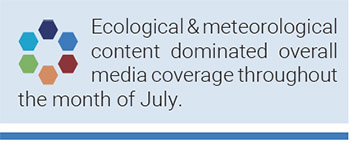 Ecological and meteorological content dominated overall media coverage throughout the month of July. Of note, Europe faced a number of heat waves in July that were tied to changes in the climate. Starting the month, records were set across the continent. Many stories documented the record-breaking heat. For example, journalist Rob Picheta from CNN reported on July 1, “Europe's scorching heat wave expanded across the continent on Saturday, with people from Britain to the Balkans sweltering under abnormally high temperatures after a record-breaking week. France is expecting temperatures of 39 degrees Celsius (103 degrees Fahrenheit) in parts on Saturday, a day after it shattered its record mark multiple times in one day. Spain, which is dealing with the aftermath of a wildfire that tore through 10,000 acres of forest in the country's north-east on Friday, is bracing for temperatures of up to 42 degrees, according to its national meteorological body AEMET. The country is still affected by a "mass of tropical wind coming from Africa," the agency said. And the UK saw its hottest day of the year by some distance, with the mercury rising to 33 degrees Celsius (91.4 Fahrenheit) and threatening the country's hottest-ever June mark of 35.6 degrees, set in 1976”. A few days later, reporter Doyle Rice from USA Today linked the high temperatures to the hottest global June on record. He noted, “Global warming exacerbated the heat wave that baked Europe late last week, a report released Tuesday said. The news came as a separate report said the globe sweltered to its hottest June on record. Europe's heat wave, which included France's all-time high temperature of 114.6 degrees last week, was “made more likely and more intense by human-induced climate change,” the World Weather Attribution group said in a release. They also said this is true for every heat wave in Europe nowadays. Specifically, the report said the extreme conditions from June 26-28 in Toulouse, France, were as much as 10 times more likely now than they were in 1900, before greenhouse gas emissions from industry had a major effect on the atmosphere. The burning of fossil fuels such as coal, oil and gas releases greenhouse gases such as carbon dioxide and methane into our atmosphere, which has warmed the planet to levels that cannot be explained by natural causes”.
Ecological and meteorological content dominated overall media coverage throughout the month of July. Of note, Europe faced a number of heat waves in July that were tied to changes in the climate. Starting the month, records were set across the continent. Many stories documented the record-breaking heat. For example, journalist Rob Picheta from CNN reported on July 1, “Europe's scorching heat wave expanded across the continent on Saturday, with people from Britain to the Balkans sweltering under abnormally high temperatures after a record-breaking week. France is expecting temperatures of 39 degrees Celsius (103 degrees Fahrenheit) in parts on Saturday, a day after it shattered its record mark multiple times in one day. Spain, which is dealing with the aftermath of a wildfire that tore through 10,000 acres of forest in the country's north-east on Friday, is bracing for temperatures of up to 42 degrees, according to its national meteorological body AEMET. The country is still affected by a "mass of tropical wind coming from Africa," the agency said. And the UK saw its hottest day of the year by some distance, with the mercury rising to 33 degrees Celsius (91.4 Fahrenheit) and threatening the country's hottest-ever June mark of 35.6 degrees, set in 1976”. A few days later, reporter Doyle Rice from USA Today linked the high temperatures to the hottest global June on record. He noted, “Global warming exacerbated the heat wave that baked Europe late last week, a report released Tuesday said. The news came as a separate report said the globe sweltered to its hottest June on record. Europe's heat wave, which included France's all-time high temperature of 114.6 degrees last week, was “made more likely and more intense by human-induced climate change,” the World Weather Attribution group said in a release. They also said this is true for every heat wave in Europe nowadays. Specifically, the report said the extreme conditions from June 26-28 in Toulouse, France, were as much as 10 times more likely now than they were in 1900, before greenhouse gas emissions from industry had a major effect on the atmosphere. The burning of fossil fuels such as coal, oil and gas releases greenhouse gases such as carbon dioxide and methane into our atmosphere, which has warmed the planet to levels that cannot be explained by natural causes”.
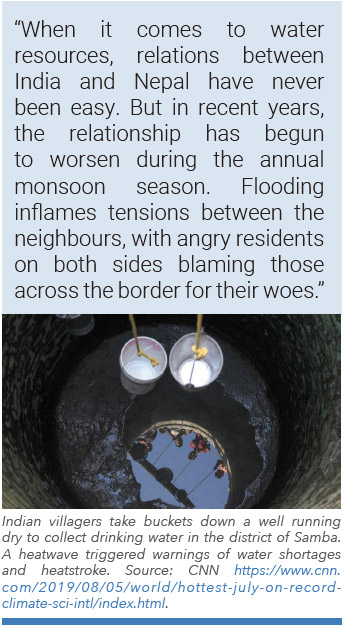 Also in early July, denizens along the US Gulf Coast braced for the impacts of Hurricane Barry to start the hurricane season. Just missing New Orleans, residents across the US state of Louisiana nonetheless were impacted. Numerous stories ran that tracked the storm and made links between hurricane events and climate change. For example, leading up to the storm making landfall, US National Public Radio journalist Rebecca Hersher reported, “People across southern Louisiana are spending the weekend worried about flooding. The water is coming from every direction: the Mississippi River is swollen with rain that fell weeks ago farther north, and a storm called Barry is pushing ocean water onshore while it drops more rain from above. It's a situation driven by climate change, and one that Louisiana has never dealt with, at least in recorded history. And it's raising questions about whether New Orleans and other communities are prepared for such an onslaught”. As a second example, journalists Kathy Finn and Timothy Gardner from Reuters wrote, “While no single storm can be linked directly to climate change, the trend of warming air and seas around the globe has caused conditions that scientists say will, on average, make storms stronger and rainier”. In the wake of the storm, New York Times journalist Christopher Flavelle reported, “New research shows that the extreme weather and fires of recent years, similar to the flooding that has struck Louisiana and the Midwest, may be making Americans sick in ways researchers are only beginning to understand. By knocking chemicals loose from soil, homes, industrial-waste sites or other sources, and spreading them into the air, water and ground, disasters like these — often intensified by climate change — appear to be exposing people to an array of physical ailments including respiratory disease and cancer ... The movement of toxic substances by storms and wildfires joins a long list of threats that climate change poses to Americans’ health, whether they be more severe heat waves or the spread of dengue or other ailments previously restricted to the tropics. What makes this threat different, researchers say, is the ability of many contaminants to persist in the environment or in people’s bodies after the disaster has passed, and to accumulate in with each new storm or fire”.
Also in early July, denizens along the US Gulf Coast braced for the impacts of Hurricane Barry to start the hurricane season. Just missing New Orleans, residents across the US state of Louisiana nonetheless were impacted. Numerous stories ran that tracked the storm and made links between hurricane events and climate change. For example, leading up to the storm making landfall, US National Public Radio journalist Rebecca Hersher reported, “People across southern Louisiana are spending the weekend worried about flooding. The water is coming from every direction: the Mississippi River is swollen with rain that fell weeks ago farther north, and a storm called Barry is pushing ocean water onshore while it drops more rain from above. It's a situation driven by climate change, and one that Louisiana has never dealt with, at least in recorded history. And it's raising questions about whether New Orleans and other communities are prepared for such an onslaught”. As a second example, journalists Kathy Finn and Timothy Gardner from Reuters wrote, “While no single storm can be linked directly to climate change, the trend of warming air and seas around the globe has caused conditions that scientists say will, on average, make storms stronger and rainier”. In the wake of the storm, New York Times journalist Christopher Flavelle reported, “New research shows that the extreme weather and fires of recent years, similar to the flooding that has struck Louisiana and the Midwest, may be making Americans sick in ways researchers are only beginning to understand. By knocking chemicals loose from soil, homes, industrial-waste sites or other sources, and spreading them into the air, water and ground, disasters like these — often intensified by climate change — appear to be exposing people to an array of physical ailments including respiratory disease and cancer ... The movement of toxic substances by storms and wildfires joins a long list of threats that climate change poses to Americans’ health, whether they be more severe heat waves or the spread of dengue or other ailments previously restricted to the tropics. What makes this threat different, researchers say, is the ability of many contaminants to persist in the environment or in people’s bodies after the disaster has passed, and to accumulate in with each new storm or fire”.
On the other side of the planet, floods and consequent landslides in Asia also captured media attention. Areas of Nepal, Bangladesh and India faced intense rains as the monsoon season gripped the region. For example, BBC correspondent Navin Singh Khadka wrote, “When it comes to water resources, relations between India and Nepal have never been easy. But in recent years, the relationship has begun to worsen during the annual monsoon season, which lasts from June to September. Flooding inflames tensions between the neighbours, with angry residents on both sides blaming those across the border for their woes. This year, floods have been wreaking havoc in the region. Dozens have been killed in Nepal and Bangladesh, and more than three million people have been displaced in north and north-eastern India…Now, as climate change makes the monsoon itself erratic, experts fear that the issues between the two neighbours could become far more complicated”.
As July progressed, a ‘heat dome’ that sat over much of the US then garnered media attention to links to changes in the climate. Record-breaking temperatures from the US heartland to the east coast left five dead and thousands without power due to demand surges. Journalist Doyle Rice from USA Today warned, “If you think it's hot now, just wait awhile. As the globe warms in the years ahead, days with extreme heat are forecast to skyrocket across hundreds of U.S. cities, a new study suggests, perhaps even breaking the ‘heat index’”. Meanwhile, in an article titled ‘Heat Waves in the Age of Climate Change: Longer, More Frequent and More Dangerous’ journalist Kendra Pierre-Louis wrote, “people with health issues, older people and young children are especially susceptible to the effects of extreme heat. It’s a threat that grows as climate change continues,” adding, “There’s another way that climate change worsens heat waves: by changing the jet stream. Those air currents in the atmosphere help move weather systems around and are driven by temperature differences, which are shrinking. So when heat waves arrive, they stay in place longer”.
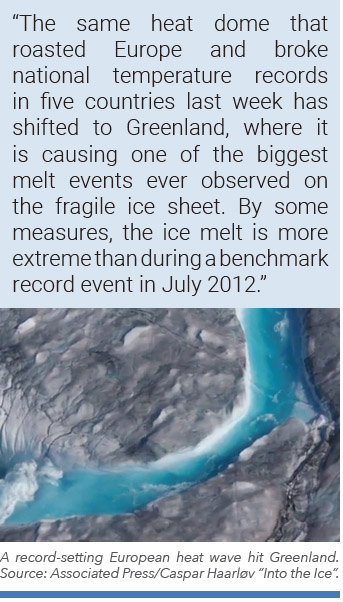 Following that heat dome in North America, another heatwave baked Europe. Media covered temperature records falling across Germany, France, the UK, the Netherlands and Belgium. For example, journalists Angela Charlton and Kirsten Grieshaber from the Associated Press wrote in an article titled ‘Europe melts under Sahara heat wave, smashing heat records’, “Even ice cream, Italian gelato or Popsicles couldn’t help this time. Temperature records that had stood for decades or even just hours fell minute by minute Thursday afternoon and Europeans and tourists alike jumped into fountains, lakes, rivers or the sea to escape a suffocating heat wave rising up from the Sahara. On a day that no one on the continent will ever forget, two potential drug dealers in Belgium even called the police, begging to be rescued from the locked container they managed to get themselves trapped in. It was nearly impossible to keep up with the falling records as temperatures climbed higher and higher under a brutal sun — in Paris and London, in Belgium, Germany, the Netherlands — all places where air conditioning is not typically installed in homes, cafes or stores. Even office air conditioning systems strained under the hot, dry air that was trapped between two stormy weather systems. Climate scientists warned these types of heat waves could become the new normal but they loom as a giant challenge for temperate Europe. As emissions keep warming the planet, scientists say there will be more and hotter heat waves, although it’s too early to know whether this specific hot spell is linked to man-made climate change”. Meanwhile, Guardian journalist Jon Henley explained, “Germany, the Netherlands and Belgium have recorded all-time national temperature highs for the second day running and Paris has had its hottest day ever as the second dangerous heatwave of the summer sears western Europe. The extreme temperatures follow a similar heatwave last month that made it the hottest June on record. Scientists say the climate crisis is making summer heatwaves five times more likely and significantly more intense”.
Following that heat dome in North America, another heatwave baked Europe. Media covered temperature records falling across Germany, France, the UK, the Netherlands and Belgium. For example, journalists Angela Charlton and Kirsten Grieshaber from the Associated Press wrote in an article titled ‘Europe melts under Sahara heat wave, smashing heat records’, “Even ice cream, Italian gelato or Popsicles couldn’t help this time. Temperature records that had stood for decades or even just hours fell minute by minute Thursday afternoon and Europeans and tourists alike jumped into fountains, lakes, rivers or the sea to escape a suffocating heat wave rising up from the Sahara. On a day that no one on the continent will ever forget, two potential drug dealers in Belgium even called the police, begging to be rescued from the locked container they managed to get themselves trapped in. It was nearly impossible to keep up with the falling records as temperatures climbed higher and higher under a brutal sun — in Paris and London, in Belgium, Germany, the Netherlands — all places where air conditioning is not typically installed in homes, cafes or stores. Even office air conditioning systems strained under the hot, dry air that was trapped between two stormy weather systems. Climate scientists warned these types of heat waves could become the new normal but they loom as a giant challenge for temperate Europe. As emissions keep warming the planet, scientists say there will be more and hotter heat waves, although it’s too early to know whether this specific hot spell is linked to man-made climate change”. Meanwhile, Guardian journalist Jon Henley explained, “Germany, the Netherlands and Belgium have recorded all-time national temperature highs for the second day running and Paris has had its hottest day ever as the second dangerous heatwave of the summer sears western Europe. The extreme temperatures follow a similar heatwave last month that made it the hottest June on record. Scientists say the climate crisis is making summer heatwaves five times more likely and significantly more intense”.
To round out the scorching month in the Northern Hemisphere, Greenland was reported to also have suffered a heat wave, leading to rapid ice melt and forest fire outbreaks. In a Washington Post article entitled ‘The Greenland ice sheet is in the throes of one of its greatest melting events ever recorded’, journalists Jason Samenow and Andrew Freedman reported, “The same heat dome that roasted Europe and broke national temperature records in five countries last week has shifted to Greenland, where it is causing one of the biggest melt events ever observed on the fragile ice sheet. By some measures, the ice melt is more extreme than during a benchmark record event in July 2012, according to scientists analyzing the latest data. During that event, about 98 percent of the ice sheet experienced some surface melting, speeding up the process of shedding ice into the ocean. The fate of Greenland’s ice sheet is of critical importance to every coastal resident in the world, since Greenland is already the biggest contributor to modern-day sea level rise. The pace and extent of Greenland ice melt will help determine how high sea levels climb and how quickly”.
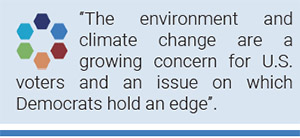 In addition to heat waves, hurricanes and flooding capturing media attention through associations with climate change, media stories also addressed political and economic connections with climate issues around the world. For example, in the US, market forces and insurance company pull-back struck the coal industry. Journalist Oliver Ralph from the Los Angeles Times noted, “Up to now, U.S. insurers have resisted joining the growing movement in Europe to stop selling insurance to coal-based power plants and coal mines because of the environmental damage they cause”. Meanwhile, BBC News reported, “Chubb has become the latest major insurer to cut its exposure to the coal industry, citing climate change. The firm will no longer underwrite the building and operation of new coal-fired plants or new risks for companies that generate more than 30% of their revenues from coal mining. Chairman Evan G. Greenberg said Chubb accepts "the reality of climate change... on our planet". Allianz, Hannover, and Lloyds Banking Group have scaled back coal insurance. The Switzerland-based insurer does most of its business in the US, where President Donald Trump has vowed to revive the coal sector. Chubb is thought to be the biggest insurer operating in the US to introduce the policy, and it could put pressure on firms such as AIG and Travelers to follow suit”.
In addition to heat waves, hurricanes and flooding capturing media attention through associations with climate change, media stories also addressed political and economic connections with climate issues around the world. For example, in the US, market forces and insurance company pull-back struck the coal industry. Journalist Oliver Ralph from the Los Angeles Times noted, “Up to now, U.S. insurers have resisted joining the growing movement in Europe to stop selling insurance to coal-based power plants and coal mines because of the environmental damage they cause”. Meanwhile, BBC News reported, “Chubb has become the latest major insurer to cut its exposure to the coal industry, citing climate change. The firm will no longer underwrite the building and operation of new coal-fired plants or new risks for companies that generate more than 30% of their revenues from coal mining. Chairman Evan G. Greenberg said Chubb accepts "the reality of climate change... on our planet". Allianz, Hannover, and Lloyds Banking Group have scaled back coal insurance. The Switzerland-based insurer does most of its business in the US, where President Donald Trump has vowed to revive the coal sector. Chubb is thought to be the biggest insurer operating in the US to introduce the policy, and it could put pressure on firms such as AIG and Travelers to follow suit”.
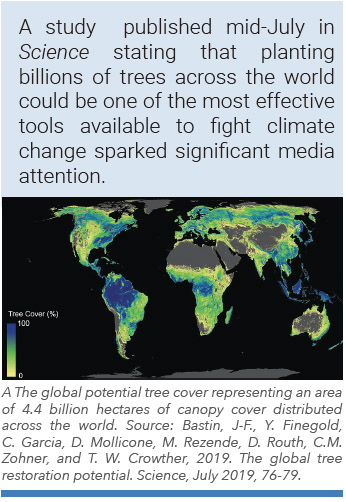 Also in the US, in mid-July President Donald J. Trump delivered a speech promoting his environmental record, and this grabbed the attention of many media outlets. Amid widespread coverage, journalists Katie Rogers and Coral Davenport from The New York Times reported, “for nearly an hour in the East Room on Monday afternoon, Mr. Trump sought to recast his administration’s record by describing what he called “America’s environmental leadership” under his command. Flanked by several cabinet members and senior environmental officials — one a former lobbyist for the coal industry and the other a former oil lobbyist — Mr. Trump rattled off a grab bag of his administration’s accomplishments, which he said included “being good stewards of our public land,” reducing carbon emissions and promoting the “cleanest air” and “crystal clean” water... David G. Victor, the director of the Laboratory on International Law and Regulation at the University of California, San Diego, said the speech was the starkest example to date of the disconnect between Mr. Trump’s rhetoric and reality. “This speech is a true ‘1984’ moment,” he said”. Also, journalist Jennifer Ludden from National Public Radio noted, “President Trump used the pomp and circumstance of the East Room, complete with an entrance to "Hail to the Chief" and a bevy of supportive Cabinet members, to tout "America's Environmental Leadership" on Monday. There was no new policy announcement. In fact, the event felt mostly like a campaign rally. But it may amount to recognition that the environment and climate change are a growing concern for U.S. voters and an issue on which Democrats hold an edge”.
Also in the US, in mid-July President Donald J. Trump delivered a speech promoting his environmental record, and this grabbed the attention of many media outlets. Amid widespread coverage, journalists Katie Rogers and Coral Davenport from The New York Times reported, “for nearly an hour in the East Room on Monday afternoon, Mr. Trump sought to recast his administration’s record by describing what he called “America’s environmental leadership” under his command. Flanked by several cabinet members and senior environmental officials — one a former lobbyist for the coal industry and the other a former oil lobbyist — Mr. Trump rattled off a grab bag of his administration’s accomplishments, which he said included “being good stewards of our public land,” reducing carbon emissions and promoting the “cleanest air” and “crystal clean” water... David G. Victor, the director of the Laboratory on International Law and Regulation at the University of California, San Diego, said the speech was the starkest example to date of the disconnect between Mr. Trump’s rhetoric and reality. “This speech is a true ‘1984’ moment,” he said”. Also, journalist Jennifer Ludden from National Public Radio noted, “President Trump used the pomp and circumstance of the East Room, complete with an entrance to "Hail to the Chief" and a bevy of supportive Cabinet members, to tout "America's Environmental Leadership" on Monday. There was no new policy announcement. In fact, the event felt mostly like a campaign rally. But it may amount to recognition that the environment and climate change are a growing concern for U.S. voters and an issue on which Democrats hold an edge”.
Moving from ecological and meteorological as well as political and economic dimensions of climate change stories in the media in July, additional attention was paid to cultural stories. For example, the fast-moving trend of universities, cities, states and countries declaring ‘climate emergencies’ generated media stories. For instance, Associated Press journalist Edith M. Lederer wrote, “Networks and organizations representing more than 7,000 institutions of higher and further education around the world have signed a letter declaring “a climate emergency” and committing to tackle it, the U.N. Environment agency said Wednesday. U.N. Environment representative Sam Barrett announced the initiative at a U.N. meeting promoting higher education. Organizers said they hope 10,000 institutions will sign the letter by the end of 2019. The letter says: “The young minds that are shaped by our institutions must be equipped with the knowledge, skills and capability to respond to the ever-growing challenges of climate change.” It commits the institutions to support a three-point plan that includes mobilizing resources for climate change research, increasing education on preserving the environment, and going carbon neutral by 2030, or 2050 at the very latest”.
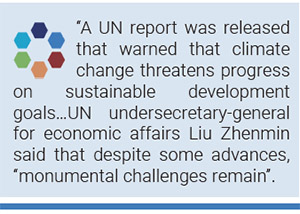 And not to be left behind, scientific ways of knowing about climate change also pervaded media stories in July. Among them, a new study of rapid sea ice decline in Antarctica grabbed attention. For example, journalist Seth Borenstein from the Associated Press wrote, “The amount of ice circling Antarctica is suddenly plunging from a record high to record lows, baffling scientists. Floating ice off the southern continent steadily increased from 1979 and hit a record high in 2014. But three years later, the annual average extent of Antarctic sea ice hit its lowest mark, wiping out three-and-a-half decades of gains — and then some, a NASA study of satellite data shows.”
And not to be left behind, scientific ways of knowing about climate change also pervaded media stories in July. Among them, a new study of rapid sea ice decline in Antarctica grabbed attention. For example, journalist Seth Borenstein from the Associated Press wrote, “The amount of ice circling Antarctica is suddenly plunging from a record high to record lows, baffling scientists. Floating ice off the southern continent steadily increased from 1979 and hit a record high in 2014. But three years later, the annual average extent of Antarctic sea ice hit its lowest mark, wiping out three-and-a-half decades of gains — and then some, a NASA study of satellite data shows.”
Also, a study published mid-July in Science stating that planting billions of trees across the world could be one of the most effective tools available to fight climate change sparked significant media attention. For example, at the BBC journalist Manish Pandey wrote, “Planting trees is now the best way to tackle rising temperatures and climate change, according to a study this week from a group of scientists. Trees absorb carbon dioxide which means they can help to stop rising temperatures around the world. They also keep soil moist and reduce the risk of flooding”. Meanwhile, reporter Stephanie Demarco from the Los Angeles Times noted, “By removing carbon dioxide from the air, trees are one of our strongest allies in the fight against climate change. And if we planted a whole lot more of them in just the right places, they could reduce the amount of carbon in the atmosphere to levels not seen in nearly 100 years, researchers say. After examining more than 70,000 high-quality satellite photos of trees from all over the planet, ecologists concluded that the Earth could support 900 million additional hectares of tree cover. Those trees would eliminate about two-thirds of the carbon that's in the atmosphere today as a result of human activities”. But media attention was garnered in part through critiques and some context-setting. For example, a Guardian editorial reminded readers, “It won’t be enough, of course. Important – vital – as these efforts are to reduce the amount of carbon dioxide in the atmosphere, and undo some of the damage we have done in the last century, they will be wholly inadequate without a corresponding effort to stop the production of more greenhouse gases”.
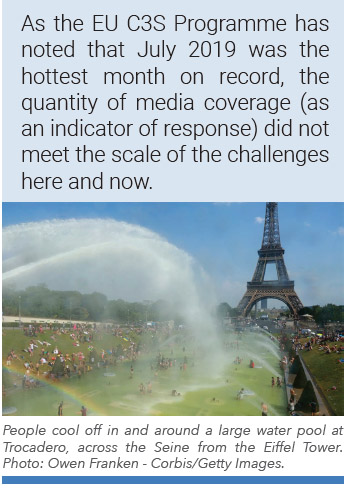 And a United Nations (UN) report was released in July that warned that climate change threatens progress on sustainable development. Among a number of alarming findings, the report pointed out that “an estimated 821 million people were undernourished in 2017” (up from 784 million in 2015) and “the worst hit region is sub-Saharan Africa, where the number of undernourished people increased from 195 million in 2014 to 237 million in 2017”. The report also warned that more than 55% of children globally “lacked minimum proficiency in reading and mathematics” while they observed “investment in fossil fuels continues to be higher than investment in climate activities”. Among media coverage of this report, journalist Edith M. Lederer from the Associated Press noted that UN undersecretary-general for economic and social affairs Liu Zhenmin said that despite some advances, “monumental challenges remain”.
And a United Nations (UN) report was released in July that warned that climate change threatens progress on sustainable development. Among a number of alarming findings, the report pointed out that “an estimated 821 million people were undernourished in 2017” (up from 784 million in 2015) and “the worst hit region is sub-Saharan Africa, where the number of undernourished people increased from 195 million in 2014 to 237 million in 2017”. The report also warned that more than 55% of children globally “lacked minimum proficiency in reading and mathematics” while they observed “investment in fossil fuels continues to be higher than investment in climate activities”. Among media coverage of this report, journalist Edith M. Lederer from the Associated Press noted that UN undersecretary-general for economic and social affairs Liu Zhenmin said that despite some advances, “monumental challenges remain”.
Our international MeCCO team remains steadfast in our commitment to monitoring and describing significant trends in media coverage of climate change around the world. Through our tracking of 96 sources (television, radio and newspapers) across 43 countries, we will continue to work to keep our finger on the pulse of these influential organizations that bridge from the formal spaces of climate science and policy into our everyday lived experiences. As the European Union Copernicus Climate Change Programme has noted that July 2019 was the hottest month on record, the quantity of media coverage (as an indicator of response) did not meet the scale of the challenges here and now. Stay tuned.
